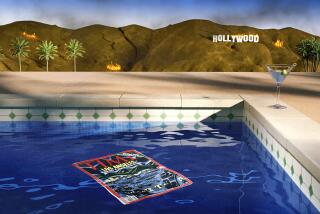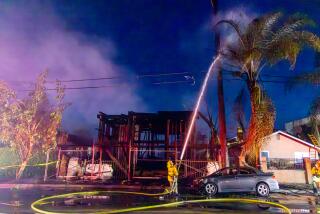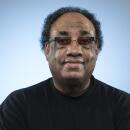Looting and Fires Ravage L.A. : 23 Dead, 572 Injured; 1,000 Blazes Reported : Unrest: Troops begin deployment and a dusk-to-dawn curfew is clamped into place in the second day of violence.
Thousands of looters ransacked stores and set fires Thursday in a chaotic rampage through the Los Angeles area as National Guard troops moved into the streets and a dusk-to-dawn curfew was clamped into force.
The violence showed no signs of abating.
Triggered by Wednesday’s acquittals of four Los Angeles police officers in the beating of black motorist Rodney G. King, the second day of mushrooming violence pushed the death toll to 23, while another 572 suffered injuries, 100 of them critical.
In a period of a little more than 24 hours, about 1,000 structural fires were reported in Los Angeles County. It seemed as though, with each passing moment, fresh flames rose from new locations, sending ripples of fear through neighborhoods both close to and miles away from the mayhem.
As dusk approached, Police Commission President Stanley K. Sheinbaum said even the National Guard and the California Highway Patrol will not be enough to quiet unrest, which he said was spreading throughout the city.
“The problem is widening, intensifying,” Sheinbaum said. “You have a whole social upheaval.”
Unlike the Watts riots of 1965, the violence this time has not been confined to an isolated area. Looters pilfered merchandise from mini-malls and swap meets throughout a combat zone that stretched from near downtown, through South-Central neighborhoods and toward the Westside. At some sites, there was such a crowd on the take that gridlock snarled the parking lots as looters attempted to drive off with their goods.
As they casually carted off everything from guns to diapers, some expressed fury over the King verdicts, but others went about their work in high spirits, seeming to enjoy the anarchy of the moment.
The rioters “chose the opportunity to steal, loot, vandalize and, indeed, to kill,” Mayor Tom Bradley said in his second public appeal in less than 12 hours, as he struggled unsuccessfully to bring the city under control. “That, we cannot--and we will not--tolerate.”
- By late afternoon, after lengthy delays, hundreds of National Guardsmen started taking up positions in hot spots around the city, including one near Koreatown, where rioters set stores ablaze and looted merchandise--a scene played out countless times in the greater Los Angeles area. Near the Los Angeles Memorial Coliseum, where three fires burned heavily and a man was shot at around 5 p.m, guardsmen were taunted as they tried to keep control of the area.
- Police rode shotgun for firefighters who had to dodge sporadic gunfire as they battled about 300 blazes in stores and at least one apartment building. As a pall of smoke fell across the region, much of Los Angeles’ daily business ground to a halt. Government offices, courthouses, law firms and schools closed out of precautionary fear.
- As criticism of the Los Angeles Police Department’s handling of the crisis mounted, Chief Daryl F. Gates admitted that his troops were overwhelmed in their initial response.
- Flights were being rerouted into the Los Angeles International Airport, causing serious delays or cancellations. “We want to keep them (jets) high enough over the area of the looting to prevent small-arms fire from reaching those airplanes,” a federal aviation spokesman said.
The Police Response
As 2,400 National Guardsmen slowly moved into place late Thursday, Gates admitted that his force was not prepared for the eruption after the King verdicts--despite his highly publicized warnings to officers of potential trouble.
“We were simply overwhelmed,” Gates said in a news conference. He was dressed in full police uniform with a holster on his hip, and was flanked by Fire Chief Donald Manning.
The two said the rapid escalation and spread of the violence caught authorities off guard.
“For a period of time from midnight to about 3 o’clock, we were getting about three new fires a minute,” Manning said. “We had numerous situations where there were attempts to kill firefighters. Here you have a group of people who are out doing their absolute best to protect others’ lives, and people are trying to kill them.
“They tried to kill them with axes, they tried to kill them with gunshots. They tried to kill them in a number of ways.”
Despite these comments, the National Guard was not immediately deployed after Gov. Pete Wilson authorized its use late Wednesday. Most arrived early Thursday but spent the morning on refresher courses while awaiting the order from Los Angeles authorities to take up positions.
By late afternoon, guardsmen armed with loaded M-16 rifles and riding in armored cars were dispatched to numerous hot spots. Some were stationed at the corner of Martin Luther King Boulevard and Vermont Avenue where rioters had battled over a strip mall most of the day.
“It’s scary, absolutely scary,” said Staff Sgt. Jack Nix, a 19-year guard veteran who lives in the Bay Area. A military police officer by profession, Nix was standing in front of a graffiti-covered wall with the message “This is for Rodney King.”
“When it gets dark,” Nix said, “it gets much worse.” As he spoke, ashes from half a dozen fires in the immediate area landed on his helmet.
Many of the guardsmen appeared jittery, although a number served in Operation Desert Storm.
“This is a lot different from attacking an Iraqi bunker,” Col. Roger Goodrich said. “There you know who the enemy is. Here there are many unknowns. . . . This is citizen soldiers facing citizens.”
On the Streets
With thick smoke clouding the air and car horns and burglar alarms blaring, crowds of looters swarmed dozens of stores with seemingly little fear of reprisal. Businesses were sacked along every major thoroughfare running from Koreatown into South-Central Los Angeles, and by midafternoon it spread into Watts, Compton and Westwood.
The looting rapidly became a free-for-all. Entire families unabashedly made off with sacks of food, clothing, tennis shoes and auto parts snatched from dozens of stores.
Police periodically moved in to clear an area, but as soon as the officers were gone, the rush resumed.
Israel Diaz, who works for a glass company, was boarding up his second grocery store of the day at the corner of Slauson Avenue and Avalon Boulevard. Looters continued to run in and out of the market even as he worked.
“There were even little kids running in for their parents,” an astonished Diaz said. “ ‘Go on in, run in there and get more,’ ” men and women told their children, he reported.
In the Crenshaw District, pregnant women took food, and one woman yelled from a car to her 9-year-old daughter to retrieve a box of Pampers for her younger siblings.
Along Washington Boulevard, a crowd of about 200 people raided markets as two raging fires gutted a portion of one city block.
“It’s kids, women with children, an exasperated Thomas Gutierrez, 40, said as he guarded his own auto parts store. “We can’t call the cops. We can’t call anyone. You’re on your own. Is there ever going to be an end to this?”
Some residents videotaped the plunder.
“I don’t believe in stealing,” said a security guard taping people looting a Farmer John’s meat freezer, “but it’s history, and I want to have a piece of it.”
Throughout portions of the city, sidewalks were littered with glass from shattered windows, trash and charred ruins.
Near the bustling intersection of 3rd Street and Vermont Avenue, residents were evacuated from an apartment building shortly before noon after arsonists set it afire.
Yvonne Latchison, 22, was watching television coverage of the unrest when someone ran through the building yelling that it was on fire. She and other residents escaped unharmed.
With the fire eventually contained, the scene at that intersection continued to verge on chaos most of the day, as a crowd of several hundred youths surged into grocery stores and mini-malls, while overwhelmed police looked on helplessly.
A Vons and Thrifty drugstore at the intersection were stormed shortly after noon to a chorus of war whoops and cheers. A trash can went through a window and within minutes a woman emerged with eight bottles of champagne, several cartons of cigarettes and a boom box.
A 31-year-old Altadena man, who emerged with similar booty, said, “This is not just us tearing apart our community. Everybody is pissed off. We have tried to be peaceful, but that didn’t work.”
Looters also traveled west on Wilshire Boulevard, tearing an iron grill off a jewelry store at Vermont Avenue. Women strolled the streets toting bright green and orange laundry baskets piled high with recently stolen detergent and toilet paper.
At Mariposa Avenue, looters stormed a Big 5 sporting goods store, carrying out armfuls of rifles, baseball caps and coolers. A few children, who could not have been any older than 12, made off with crossbows under their arms.
Another Big 5, where Wilshire meets San Vicente Boulevard at the border of Beverly Hills, was looted even as the store was open and customers milled about. The manager rushed to the front to connect the iron grill, but the mob just pushed past him and began snatching everything in sight.
A City Crippled
By midday on Thursday, Los Angeles was gradually becoming crippled by the spasms of violence, even in areas where disturbances had not been reported.
Criminal proceedings in most county courthouses were suspended, all city schools were closed and scores of private offices shut their doors and sent their employees home early. Trash collection was curtailed, and even the U.S. Postal Service said it would not deliver mail to 14 ZIP codes.
Professional sports teams canceled their games, including an NBA playoff between the Los Angeles Clippers and Utah Jazz.
Shopping centers from Eagle Rock to West L.A. closed early. At the Beverly Center, shoppers began fleeing amid semi-chaos in the parking garage. People honked horns and yelled for drivers to hurry toward the exits. The parking fee was waived and the exit arm lifted to allow people to leave quickly.
Mayor Bradley expanded an overnight curfew to the whole city after Chief Gates warned that rioting had begun “leapfrogging” to communities beyond earlier established boundaries.
“This will have a negative impact on commerce in this city and the lives of those who live here,” Bradley said at a news conference Thursday afternoon.
Bradley also said, however, that he expected police to use discretion in enforcing the curfew. “There is no way the police can arrest everybody on the street,” he said. “What we’re really looking for here is voluntary compliance.”
Lines at supermarkets from one end of the city to the other ranged from long to very long as consumers stocked up on their way home Thursday, concerned about when they would be able to buy food again.
“The lines are 20-30 people long, and every register is open,” said a manager at the Hughes’ market at 11361 National Blvd. in West Los Angeles. “People are buying very large orders--bottled water and things like that. They want to get enough stuff before the curfew.”
At USC, final examinations were to begin Thursday but were postponed until at least Monday, officials said. Many frightened students were leaving the campus and adjacent neighborhood for their families’ homes.
“Everybody’s really nervous. We’re getting out of here,” said Kacy O’Brien of Newport Beach, as she and fellow members of the Kappa Kappa Gamma sorority were hurriedly packing their cars and departing from the Greek Row on 28th Street.
Meanwhile, Gov. Wilson, his voice among many national leaders shocked and dismayed by the events in Los Angeles, said he would travel to the city to inspect damage.
Saying he was stunned by the acquittals, he said: “There can be no excusing excessive force by a police officer.”
And, he added, “There can be no excusing arson, theft, or deadly assault by a citizen. We are not going to tolerate either in California.”
The Grief
Many of the burned and looted stores belonged to Korean-born merchants. Tensions between black and Korean communities have been at high pitch for some time, and were inflamed last year when a Korean-born shopkeeper shot and killed a black girl.
As rioters roamed the streets, some said they were avenging 15-year-old Latasha Harlins’ death. But if the goal was to punish Korean-Americans, the plan backfired. Victims were people of all ethnic groups, residents of an economically depressed neighborhood that once again suffers the brunt of the destruction.
Carol Clark, the black manager of a Thrifty Pharmacy that was emptied by looters, huddled in the parking lot with her employees, fretting over their future. Can the store be repaired? Do they have a job?
“I cried last night, and I cried this morning when I saw what they had done,” she said. “This was just an opportunity to loot, and people took advantage of it. Why else would they break a glass door to our beer closet, when they could just open the door and get what they wanted?”
Like many residents, she said she believed that the violence has gone beyond rage over Wednesday’s verdict.
“This whole area was just sitting on a powder keg,” she said, “and the King verdict was the spark.”
Carlos Garcia, a resident of the neighborhood around 3rd Street and Vermont Avenue, agreed.
“Right now, they’re bringing down the place,” he said. “But two days from now, when they’re laughing and their mom sends them out to get milk, they’re going to think: Where?”
A block away from the First African Methodist Episcopal Church, where black community leaders had held an emotional rally Wednesday night to urge nonviolence, the scene Thursday was one of utter disaster.
Shopkeepers who arrived to find their small retail businesses in embers cried in grief. Others, whose stores were spared from flames, busily tacked up plywood to shore up their broken windows.
Fire consumed a market owned by a Korean family; a butcher shop owned by a Latino man; and one of two buildings of A.N. Abell Auctions, which had been in business since 1916.
Occupants of at least three four-story apartment buildings along Adams Boulevard, most of them Latinos, were burned out of their residences.
Dona Alicia Hernandez, who came to Los Angeles from El Salvador five years ago, sat in shock on a piece of luggage on the sidewalk of Adams Boulevard. Left homeless by a fire, Hernandez, head in hands, surrounded herself with her meager remaining possessions: random shoes, pots and pans, cassette tapes and a large bottle of vegetable oil stored in laundry baskets, two dresser drawers and a Salvation Army plastic shopping bag.
Others whose residences were still standing stared at the remains of laundries and markets and pondered out loud whether they would be able to get by without basic services in their neighborhood. “Now we’ll have to go all the way to Boys Market--if it’s still there,” said Velma Phillips, 37, a nightclub manager.
Outside the remains of the New Don-Re Market on Adams Boulevard, co-owner Bona Lee, 40 sobbed as she peered at the gutted interior of the block-long store. Until Wednesday night, it had housed a grocery, a coin laundry, a butcher shop, a liquor store and a hamburger stand. Thursday morning, all that remained was the front wall, embers and the charred hulks of a long row of washing machines.
“We didn’t do anything wrong,” said the tearful woman, who came to Los Angeles from Korea two decades ago. “We worked like slaves here.”
“Is this justice? What is it? We did nothing, we worked here 365 days a year. What did we do to them? Nothing.”
Donald Martin, a 30-year resident who works in an agency that provides housing to low-income people, said the violence is rooted deeply.
“This is a festering sore that at some point or another has to come to a head, and this is it,” he said. “This has probably been festering since 1965.”
More to Read
Sign up for Essential California
The most important California stories and recommendations in your inbox every morning.
You may occasionally receive promotional content from the Los Angeles Times.












